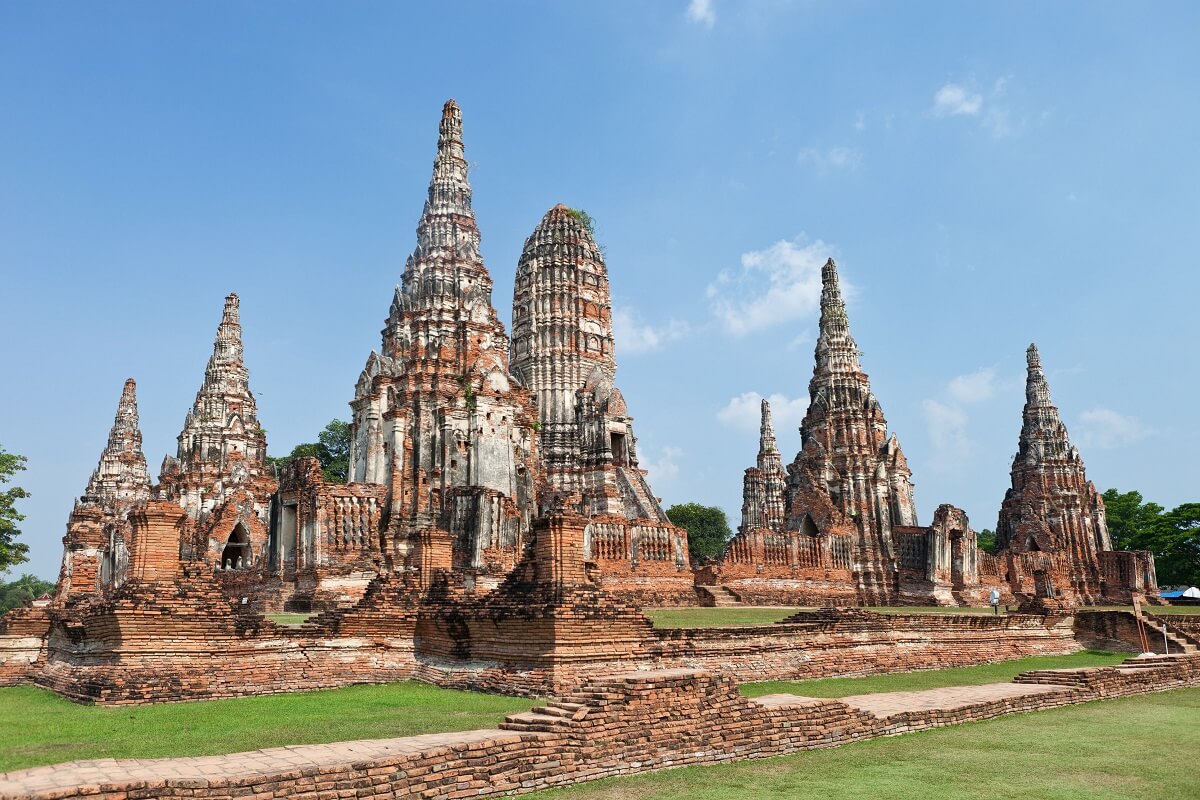When we talk about Thailand, images of sandy beaches, street food, and golden temples usually take the spotlight. But behind the laid-back island life and bustling cities lies a powerful layer of history—ancient cities, royal ruins, and fortress walls that whisper stories from centuries ago.
So, what’s the largest fort or historical site in Thailand? The crown goes to Ayutthaya Historical Park—a vast UNESCO World Heritage Site packed with grand ruins, towering stupas, crumbling palaces, and temples that once belonged to a mighty empire. This place isn’t just big in size—it’s big on impact.
Let’s walk through time and explore why Ayutthaya isn’t just Thailand’s largest historical site—but also one of its most soul-stirring.
Ayutthaya – Thailand’s Lost Kingdom
Located just 80 km north of Bangkok, Ayutthaya was once the capital of the Kingdom of Siam. Founded in 1350, it grew into one of the wealthiest and most powerful cities in the world. Imagine a city where golden temples pierced the sky and merchants from Japan to Portugal filled the markets.
At its peak, Ayutthaya rivaled cities like Paris and Beijing in size and prestige. That was until 1767, when it was destroyed by the Burmese army, leaving behind haunting ruins that still stand tall today.
What makes Ayutthaya so incredible isn’t just its size—it’s the feeling you get while walking through it. Giant stone Buddhas sit peacefully in broken temples, moss grows on once-grand staircases, and the wind carries echoes of a lost empire.
Inside the Walls – What You’ll Find in Ayutthaya Historical Park
The historical park covers over 289 hectares (715 acres) and includes dozens of temple complexes, fortifications, royal halls, and statues. It’s not just one monument—it’s an entire ancient city.
Here are a few iconic landmarks within the park:
1. Wat Mahathat
Famous for the Buddha head entwined in tree roots, this temple once housed sacred relics and was a spiritual center of Ayutthaya.
2. Wat Phra Si Sanphet
Once part of the royal palace complex, its three chedis (stupas) stand as symbols of Ayutthaya’s royal power and elegance.
3. Wat Ratchaburana
This temple has detailed carvings and a large prang (Khmer-style tower). You can even go inside to see ancient murals and relics.
4. Old City Walls and Forts
Although time has worn them down, you can still see parts of the original walls and fortifications that protected the city from invaders.
5. Ayutthaya Floating Market (nearby)
While not ancient, the market adds charm to the experience—wooden boats, traditional snacks, and cultural shows recreate the vibes of old Siam.
Ayutthaya vs. Other Major Historical Sites in Thailand
| Historical Site | Location | Area Size (approx.) | Highlights | UNESCO Status |
|---|---|---|---|---|
| Ayutthaya Historical Park | Central Thailand | 715 acres | Royal ruins, temples, ancient city layout | ✅ Yes |
| Sukhothai Historical Park | Northern Thailand | 193 acres | Birthplace of Thai writing, early temples | ✅ Yes |
| Phanom Rung Historical Park | Buriram Province | 30 acres | Khmer-style hilltop temple | ❌ No |
| Si Satchanalai | Near Sukhothai | 178 acres | Quiet ruins, pottery heritage | ✅ Yes |
| Wiang Kum Kam | Chiang Mai area | 80 acres | Submerged city ruins, Lanna architecture | ❌ No |
How to Explore Ayutthaya Like a Pro
1. Rent a Bicycle or Tuk-Tuk
The ruins are spread out, so walking can be exhausting. A bike gives you freedom and lets you take the scenic route. Tuk-tuks are great too—and shaded!
2. Go Early or Late
Avoid the midday heat. Early morning and late afternoon not only offer cooler weather but also magical lighting for photos.
3. Wear Respectful Clothing
Many temples are still sacred. Cover your shoulders and knees out of respect. Lightweight clothes and hats help beat the heat.
4. Take a River Cruise
The Chao Phraya River surrounds the old city. A boat ride gives a different view of the ruins, especially at sunset.
5. Visit the Museums
The Chao Sam Phraya National Museum has relics from Ayutthaya’s heyday—Buddha images, gold treasures, and royal artifacts that survived the fall.
Why Ayutthaya Matters (Beyond Just Size)
Sure, Ayutthaya is huge. But its true value lies in what it represents.
1. A Symbol of Thai Identity
Ayutthaya shaped Thai culture, politics, and religion. Many modern Thai customs, art styles, and even language evolved during this period.
2. A Global Crossroads
It was one of the first truly global cities in Asia. Dutch, Japanese, Persian, Indian, and Chinese traders all lived here—bringing their own cultures and creating a unique blend.
3. Lessons from the Fall
The fall of Ayutthaya is more than just a historical date. It’s a story of resilience. Even after devastation, Thailand rebuilt—leading to the rise of modern Bangkok.
4. Still Alive with Spirit
Despite being in ruins, Ayutthaya doesn’t feel lifeless. Monks still pray in some temples. Locals come to pay respects. Travelers come to connect. The past isn’t gone—it’s just evolved.
Conclusion: Ayutthaya – More Than Just Bricks and Stones
So, what is Thailand’s largest fort or historical site? It’s Ayutthaya—and not just by square footage. This place holds the heart of a kingdom that once ruled Southeast Asia. It’s massive, yes. But more than that, it’s meaningful.
Ayutthaya isn’t just a place to tick off your travel list. It’s somewhere you feel. The silence between the ruins, the breeze through the broken walls, the soft chants from a nearby temple—they all whisper, “We were here. And we mattered.”
If you want to truly understand Thailand, you need to walk through Ayutthaya. Not just for the history books, but for the experience. Go with curiosity, leave with perspective.
